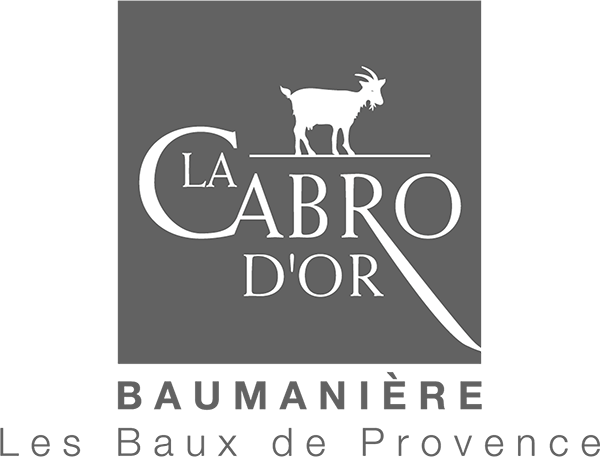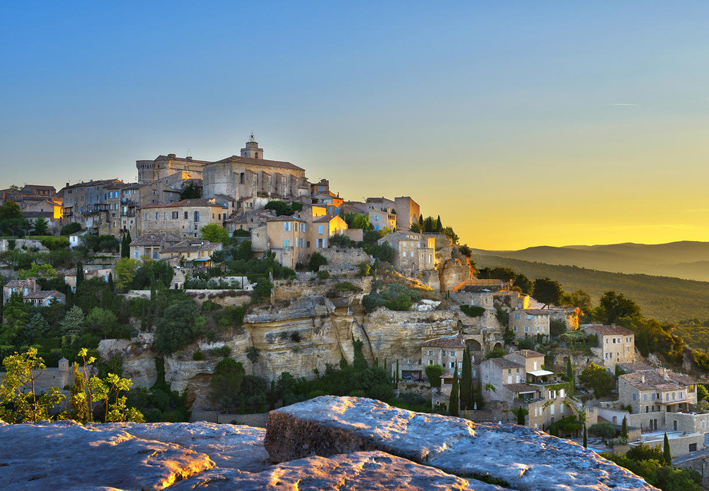From the Alpilles to the Lubéron without forgetting the villages of the Vaucluse and the Gard… For lovers of old stone, here are some not-to-be-missed sites where, in summer, lulled by the cicadas and crickets, bordered by vineyards, olive trees and flowering oleander, the scents of lavender, de rosemary and thyme awaken your senses…
Les Alpilles
(approx 1hr 20min circuit leaving from Baumanière)
• Les Baux-de-Provence (right here)
Veritable eagle’s nest, Les Baux-de-Provence is one of the most beautiful villages of France. Perched on a rocky outcrop, the medieval city looks out over the region of the Alpilles. The village is composed of shaded terraces, small lanes and little squares full of history and with a breathtaking panoramic view over the whole Valley of Les Baux. In the center of Les Baux-de-Provence, a rich architectural heritage awaits visitors with some twenty historic monuments. If you can visit only one of those emblematic monuments, let it be the castle of Les Baux-de-Provence. Grandiose witness to the town’s history, many tours of the ruins are offered throughout the year, including the medieval arsenal, the towers and keeps as well as many activities and workshops suitable to the whole family. To complete the experience, go to the not-to-be-missed and out of the ordinary Carrières de Lumière for an artistic immersion. A sound and light show projected onto the limestone rock of Les-Baux-de-Provence exhibits some of the most illustrious works of arts. This year, discover “Picasso and the Spanish Masters”, a century of Iberian paintings.
To dine at Les Baux-de-Provence:
Come to one of Baumanière’s two restaurants, Oustau de Baumanière, gourmet restaurant with 2 Michelin stars, or our Provençal restaurant La Cabro d’Or.
• Saint-Rémy-de-Provence
15 minutes from Baumanière, at the foot of the Alpilles, Saint-Rémy-de-Provence is a must visit in Provence. Its old streets and stone houses, its squares places and terraces make a unique and exceptional place and contribute to the town’s undeniable charm. Imbued with history, the town was built on an ancient Roman site dating from more than 2000 years ago, with the site of Glanum. The thermal baths, the Triumphal Arch and the Mausolée des Antiques are witnesses to the town’s past. Far from the hustle and bustle of the tourist cities on the Riviera, Saint-Rémy-de-Provence is a haven of peace where you can taste the sweet life of Provençe. A city of history and also art, Saint-Rémy-de-Provence has attracted celebrities and aesthetes. It has inspired a great number of artists with the beauty of its Roman ruins and its Provençal countryside: olive trees, cypress, poppies and wheat fields… Vincent Van Gogh is just one of the well-known eulogists with his 150 paintings depicting the town and its surroundings.
Where to dine :
Château of the Alpilles on the Route du Rougadou
La Table d’Yvan to 1 chemin Gaulois
Le Café de la Place at 17 Place de la République
Rocco at 11 Rue de la Commune
Ô CaPrices de Mathias on Chemin la Croix des Vertus
• Eygalières
30min from Baumanière, Eygalières is a small tranquil village situated a few minutes from Saint-Rémy-de-Provence. Surrounded by the stunning landscapes of the Alpilles, the village faces vast fields of olive trees, verdant valleys and vineyards. A village full of charm that has kept all its authenticity. The old houses in the village are built of stones and they all have a bit of greenery or a flowering shrub poking through the door that hints at beautiful gardens just behind.
Don’t miss the Clock Tower built in 1672 and which is a spot commemorating the independence of the village obtained by the purchase of their territory by the people of Eygalière from the Duke de Guise.
Where to dine in Eygalières:
Chez Paulette to 130 Rue de la République.
Go to Maussane by the small authentic Route du Destet with unobstructed views of the white rocks of the Alpilles between scrub land, vineyards and olive groves.
• Maussane Les Alpilles
5 minutes from Les Baux-de-Provence, surrounded by the generous nature of the Alpilles and by the olive groves, a certain sweetness of life reigns over this authentic little village. Rich in its traditions and it’s heritage, it is a pleasure to stroll through the village square and along the small streets, where you will discover an imposing washhouse built under Napoleon III.
Where to dine :
Ou Ravi Provencau
Le Clos Saint Roch
Aux Ateliers chez Franck et Flo
The villages of the Vaucluse
(for an approx. 2 hr itinerary)
Itinerary map
• L’Isle sur la Sorgue
50min from Baumanière
Nicknamed the “Venice of the Comtadine” because of its canals, just like the famous Italian city, Isle-sur-la-Sorgue is a small town bordering the Sorgue where strolls along the river have a romantic charm. Situated on the roads from Cavaillon to Carpentras and from Avignon to Apt, it is a must for those who want to visit every corner of Provence.
The village is known for its many antique fairs and also for its floating market, which takes place each year on the Sunday in August.
You will also find many edifices such as the White and Blue Penitents Chapels, and the Tour d’Argent, a tower at the centre of the town’s history. It isn’t rare to find in our rooms an object unearthed by Geneviève Charial at one of the antique dealers of Isle-sur-la-Sorgue.
Where to dine:
The Quai de la Gare
Le Carré d’herbes
• Fontaine de Vaucluse
15min from l’Isle sur la Sorgue
it is a veritable mystery of nature, Fontaine-de-Vaucluse is a village in a picturesque setting in the Vaucluse.
A geological curiosity, the spring at Fontaine-de-Vaucluse exudes a magical aspect because its origin has still not been found and it’s one of the very few to go directly into a river, the Sorgue, which has one of the biggest flows in Europe. With its reputation of bringing good luck, coins have been thrown into it since Antiquity.
In Fontaine-de-Vaucluse, you can enjoy the coolness emanating from the spring, admire the old ruins, visit the crafts shops or just simply dine or enjoy a drink on one of the restaurants’ terraces.
The spectacular landscapes, the chasm of unfathomed depth as wall as the emerald green of the river explain the spot’s popularity. The marvellous aspect of this natural site has inspired many writer and poets such as Petrarch, Boccaccio, Chateaubriand, Frédéric Mistral and René Char. Just outside the village, you can rent a canoe to paddle down the Sorgue.
Le Lubéron
1h from Baumanière
• Oppède le Vieux
Oppède le Vieux is a small but magnificent village built atop a rocky outcrop. With its streets lined by houses from the Middle Agesc and the Renaissance, all charmingly restored, the ruins of its castle and the 12th century collegiate church offering a 360° panorama with views over the Cévennes, the Basses-Alpes and the Mont Ventoux, … Oppède is full of history. Our advice: Leave your car in the carpark below the village and follow the marked paths.
• Ménerbes
In the heart of the Luberon, Ménerbes is a village perched high up on a rock. You can visit sit on foot only. Favourable just to wandering around, the village shares with you its Provençal sweetness of life. Thanks to a soil ideal for cultivating grapevines, Ménerbes comprises many vineyards producing AOC Côtes du Luberon wine and which attract many visitors each year.
The Saint-Hilaire Abbey dating from the 13th century is known for the cave-dwelling part of its edifice. Today, the abbey has been transformed into a farm but remains open to the public. The simplicity of the place and the view over the valley at the foot of the Luberon are much appreciated by visitors.
• Gordes
20min from Ménerbes
Gordes is a charming little village facing the Luberon mountain range. Classed as one of the most beautiful villages in France, Gordes is situated high up on a rocky peak. Its steep streets, old edifices and natural heritage make it a unique spot, where you can sample the olive oils and the tapenades from local farmers who will be delighted to share with your their passion for their land. It’s a village of artists celebrated by Marc Chagall, Victor Vasarely, André Lhote and Pol Mara who lived here for a while, fallen under the charm of the place.
The Bories village, listed as a historic monument, is a place of stone vestiges that testify to the rural way of life in Provençe up to the 19th century. There you will see herbs, ancient farming tools and other objects for a total immersion in the daily life of the period.
From Gordes, you are 10 minutes from the Sénanque Abbey where, staring in June, you can admire its famous lavender fields in bloom: a not-to-be-missed sight in the region!!
Where to dine :
Les Bories
Le Mas Tourteron
Restaurant Peyr – Pierre Gagnaire
• Roussillon
20min from Gordes
Situated in the Regional Nature Park of the Luberon, Roussillon is, after Gordes, one of the most visited villages in the Luberon and is labelled “most beautiful village of France”. Singular and in the heart of the biggest ochre deposit in Europe, Roussillon shines with its flamboyant colours. Strolling the streets and contemplating the authentic charm of the houses, you can truly admire Nature’s work. Many art galleries and exhibition spaces can be found in this décor, where some fifty artists are represented.
Roussillon, village of ochre, is also a village of art which has what it takes to please art lovers and the curious. Did you know? According to legend, Sermonde, the wife of the lord of Roussillon, has an affair with a troubadour from the village. When she learned about the death of her lover, killed by her husband, she threw off a cliff, leaving her blood to spread over the earth of Roussillon and giving it its ochre tint.
To see in the surrounding area: The “Colorado Provençal” is truly the exceptional and not-to-bee-missed site in the surroundings.
• Lourmarin
35min from Roussillon
Lourmarin is also quite well-known and classed among the most beautiful villages of France. Situated in the south of the Luberon, in the Vaucluse, the village is lively and refreshing with fountains at every street corner. Lourmarin is also famous for being a village of artists; Henri Bosco and Albert Camus much appreciated this town and were laid to rest in the small cemetery. Rich in works of art, collections and monuments, like its Renaissance castle, Lourmarin is a village apart where you can fully enjoy Provençal life and discover some of its secrets…
Where to dine :
l’Auberge de la Fenière, sur la Route de Lourmarin.
The Gard and the region of d’Uzes
1h by car from Baumanière
• Vers-Pont-du-Gard
A spot remarkable for its aqueduct, listed as a world heritage site by UNESCO, Vers-Pont-du-Gard is situated in the triangle between Nîmes, Uzès and Avignon. The Pont-du-Gard is the town’s attraction. This Roman aqueduct, over 2000 years old, is an impressive monument, not only for its grandeur but because it was, for the period, a veritable feat in terms of its construction.
Throughout the year, events are organized such as music festivals, entertainment, exhibitions, workshops and tours… For an activity with the family and the children, the Espace Ludo lets you immerse yourself in the Gallo-Roman era to discover the aqueduct’s origins.
At the foot of the aqueduct flows the Gardon, ideal for kayaking, bathing or just relaxing on the banks.
Our advice: in June, go watch the enchanting and grandiose sound and light show “The Fééries du Pont du Gard”.
• Uzès
20min from Pont du Gard
Uzès is a town of Art and History. An architectural gem, it has many monuments in its centre. We can cite the very beautiful ducal castle with an unobstructed view from the Bermonde Tower. And the Saint-Théodorit Cathedral with the adjoining Fénestrelle Tower in Lombardy architecture.
In addition to these cultural edifices, you will find flavoursome products at the market . The region of Uzès is also one of the regions with the greatest number of black truffle farmers.
The bonbon museum of Uzès is also well known by sweets lovers. It was in Uzès where the famous licorice rolls that delighted so many generations were first created. From the history of each sweet to its manufacture, with interactive games for children and the shop where you have a wide selection for all tastes, the tour will delight the old and young alike.
Where to dine:
La Maison d’Uzès



